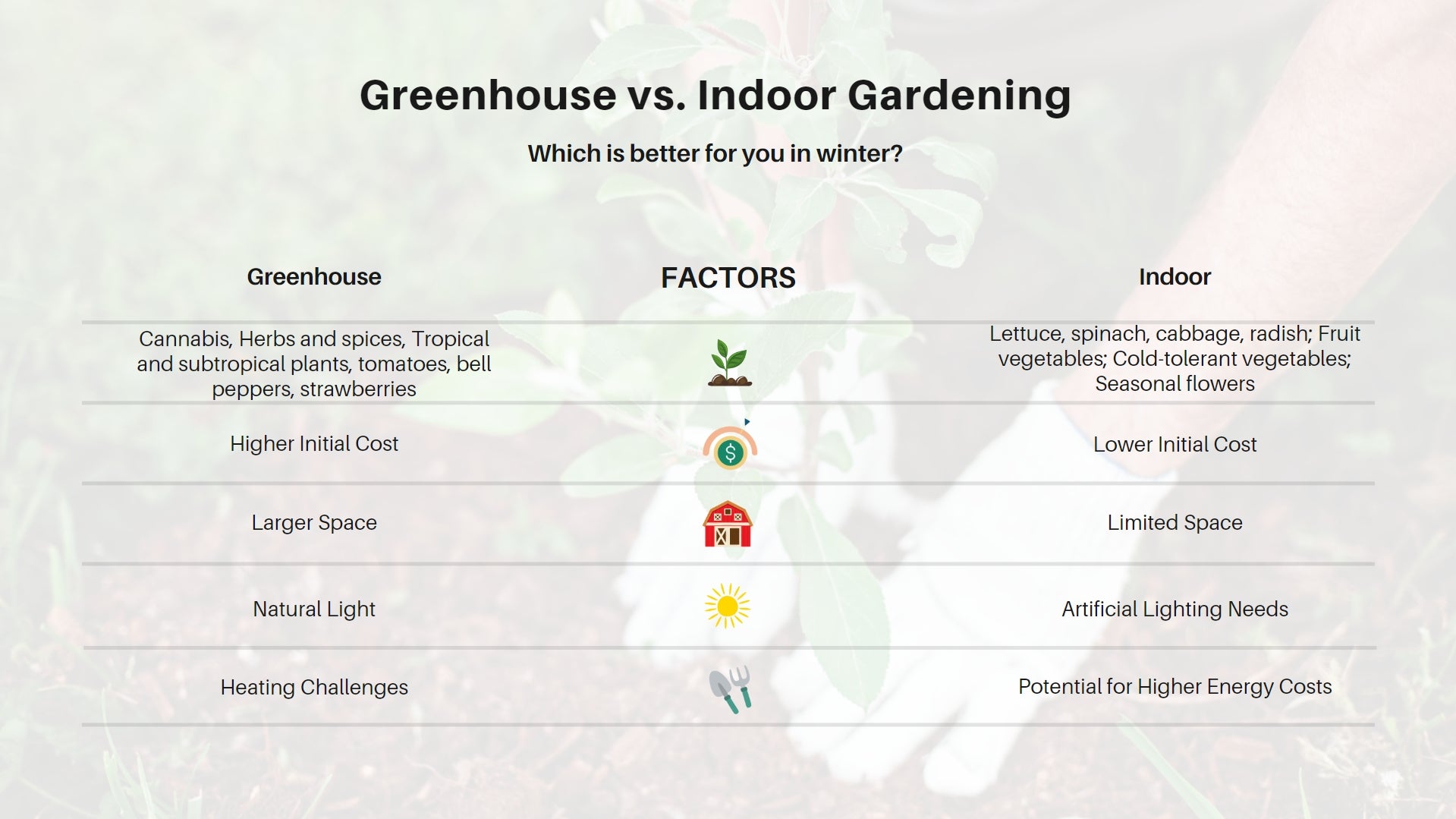How to sustain your gardening passion during the cold months? The urge to uphold an engaging gardening schedule often leads to challenging decisions about sustainable winter gardening methods to adopt. Two favored methods are greenhouse growing and indoor gardening in winter, each presenting distinct advantages and drawbacks when dealing with a cold climate. Let’s examine the details of both approaches and determine the optimal choice for your winter gardening goals.

Greenhouse Winter Gardening
For committed horticulturists aiming to extend their home gardening efforts throughout winter, greenhouse growing offers a compelling approach. This technique facilitates ongoing plant cultivation, successfully overcoming the challenges posed by chilly temperatures.
Plants Suitable for Greenhouse Gardening
-
Cannabis
-
Herbs and spices
-
Tropical and subtropical plants
-
Specialty vegetables and fruits (tomatoes, bell peppers, strawberries)
-
Early spring flowers
-
Experimental plants
✅Pros
1. Extended Growing Season
Traditional gardening is often restricted by seasonal weather changes, whereas a greenhouse enables the cultivation of a variety of winter crops throughout the cold months. With the right arrangement, gardeners can achieve year-round harvesting of fresh produce, which can enhance food security and promote healthier eating habits.
2. Natural Light
Additionally, the abundance of natural light within a greenhouse creates an optimal setting for plant growth. These structures are meticulously designed to capture sunlight, facilitating effective photosynthesis. This natural luminosity diminishes the reliance on supplemental electric lighting, leading to considerable reductions in energy expenses. The resultant energy savings can render the overall cost of greenhouse growing increasingly viable over time. Under ideal lighting conditions, plants flourish, yielding robust and plentiful harvests.

3. Larger Space
A greenhouse offers a more expansive gardening space compared to a traditional backyard plot. This generous environment empowers enthusiasts to diversify their plant selections, allowing for experimentation with a variety of species that may struggle in winter's chill. With the possibility of vertical gardening, shelving, and strategic pot placement, gardeners can optimize their output while circumventing the limitations often encountered in standard home gardening practices. This enhanced capacity to cultivate leads to greater self-sufficiency, enabling individuals to grow an abundance of their own food.

❎Cons
1. Higher Initial Cost
Despite the myriad greenhouse benefits of winter gardening, several obstacles accompany this rewarding endeavor. Chief among these challenges is the substantial initial investment needed to establish a greenhouse. Committing to a durable structure, alongside essential components such as heating systems, water management tools, and shelving, can demand a noteworthy financial outlay at the outset. For some aspiring gardeners, this economic barrier may hinder their entry, even in light of the long-term benefits.
2. Heating Challenges
Ensuring a stable temperature within a greenhouse, particularly during the frigid nights when outdoor temperatures plummet, can prove daunting. Many gardeners wrestle with the task of effectively warming their greenhouse without incurring excessive energy costs. A variety of heating methods exist—ranging from electric heaters to eco-friendlier options like solar heating—each accompanied by its own challenges and expenses.
3. Maintenance
Greenhouse maintenance necessitates a heightened level of upkeep compared to traditional gardening approaches. Gardeners must vigilantly monitor the internal conditions, adjusting humidity and temperature as needed. Additionally, the risk of light decay over time mandates consistent maintenance to ensure the greenhouse remains a productive growing environment. Routine chores, such as cleaning glass panels for optimal light transmission and overseeing irrigation systems, can become time-intensive, potentially deterring some from fully engaging in this fulfilling practice.

Indoor Winter Gardening
Embracing the art of indoor gardening in winter not only sustains your horticultural zeal but also nurtures a vibrant ecosystem within your home, ensuring that your green haven thrives amidst the frost.
Plants Suitable for Indoor Gardening
-
Common vegetables (Lettuce, spinach, cabbage, radish)
-
Fruit vegetables
-
Cold-tolerant vegetables
-
Seasonal flowers
-
Industrial crops
✅Pros
1. Complete Climate Control
A paramount advantage of indoor gardening in winter lies in the unparalleled ability to wield complete climate control. Unlike the unpredictable nature of outdoor gardening, where you are at the mercy of the elements, an indoor garden affords you the luxury of dictating temperature, humidity, and light levels. This capacity allows you to engineer an optimal growing environment tailored specifically to the diverse needs of your plants. For example, tropical species that typically falter in frigid conditions can flourish in a warm, regulated atmosphere. With the right apparatus, such as heating mats and humidifiers, you can orchestrate the ideal conditions, ultimately fostering robust plant health and extending the growing season for an array of winter crops.
2. Convenience
Convenience emerges as another compelling benefit of indoor gardening in winter. With an indoor setup, the burdensome logistics of transporting plants in and out, combating frost damage, and enduring the harshness of winter are rendered obsolete. Your plants bask in a stable environment, promoting consistent growth trajectories. You can immerse yourself in the joys of gardening from your living room, kitchen, or any available nook, insulated from the challenges posed by the outdoors. This accessibility enables more frequent tending to your plants, ensuring they receive the attention and care they deserve.
3. Lower Initial Cost
For many budding indoor gardeners, the winter months present a unique opportunity to cultivate plants with a lower initial investment compared to establishing a full-scale outdoor garden or greenhouse. The beauty of an indoor garden often lies in its simplicity; you can commence your journey with modest pots, basic lighting, and quality soil. Incorporating economical tools and materials tailored to your ambitions allows for experimentation with various plant species without a monumental financial obligation.
❎Cons
1. Limited Space
Depending on your living circumstances, the area designated for your indoor garden may be constrained, potentially influencing the number and types of plants you can cultivate. For enthusiasts with ambitions of growing a diverse array of species, creativity in utilizing available space becomes essential. Strategies such as vertical gardening or compact growing systems can maximize your indoor garden’s potential, yet these solutions may not suit everyone’s preferences.
2. Artificial Lighting Needs
One of the more formidable hurdles in indoor gardening in winter is the dependence on artificial lighting. With natural sunlight diminishing during the shorter days of winter, supplementing with grow lights becomes imperative. Not all plants adapt well to artificial illumination, particularly those accustomed to basking in direct sunlight. Therefore, selecting the appropriate type of grow light—be it LED, fluorescent, or incandescent—is vital for the prosperity of your indoor garden. Understanding the wattage and light spectrum necessary for your plants can be an overwhelming task, especially for novices.
3. Potential for Higher Energy Costs
Lastly, the endeavor of indoor gardening in winter may bring forth heightened energy costs. The necessity of heating your indoor space and powering grow lights can significantly inflate your electricity bills, particularly in the case of a large garden. Being cognizant of this financial impact is crucial; incorporating energy-efficient lighting solutions can help alleviate some of the burdens. Additionally, employing timers for your lights can optimize exposure, reducing superfluous energy consumption while ensuring your plants thrive.
Conclusion

While both methods strive to enhance crop growth effectively, they vary greatly in their operational techniques, cost requirements, and specific set-up. Our discussion of greenhouse vs. indoor gardening is designed to equip you with a clearer understanding of these sustainable winter gardening methods, ultimately empowering you to make an informed choice.
👇Other topics you might care:
1. How Should I Grow and Care for Olive Trees Autumn and Winter?
2. The Best Raised Garden Beds: 7 Popular Products Review
3. Beat the Frost: A Comprehensive Guide to Greenhouse Heating Systems








